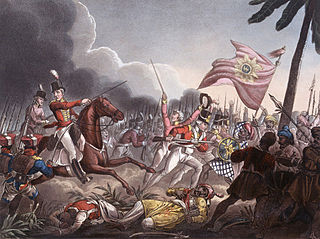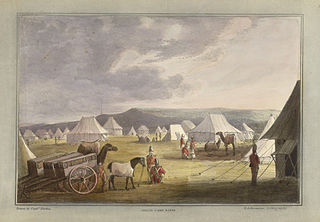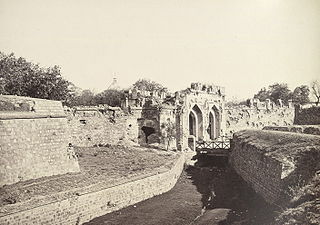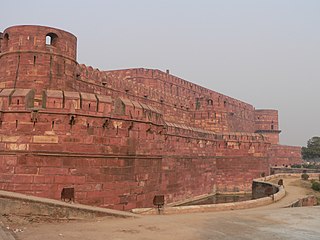
The Third Battle of Panipat took place on 14 January 1761 between the Maratha Confederacy and the invading army of the Durrani Empire. The battle took place in and around the city of Panipat, approximately 97 kilometres (60 mi) north of Delhi. The Afghans were supported by three key allies in India: Najib ad-Dawlah who persuaded the support of the Rohilla chiefs, elements of the declining Mughal Empire, and most prized the Oudh State under Shuja-ud-Daula. The Maratha army was led by Sadashivrao Bhau, who was third-highest authority of the Maratha Confederacy after the Chhatrapati and the Peshwa. The bulk of the Maratha army was stationed in the Deccan Plateau with the Peshwa.

The Maratha Confederacy, also referred to as the Maratha Empire or the Maratha Kingdom, was an early modern polity in the Indian subcontinent comprising the realms of the Peshwa and four major independent Maratha states who were often subordinate to the former. It was formed in 1674 with the coronation of Shivaji of the House of Bhonsle as the Chhatrapati of the Marathas. The Maratha realm was recognised by Bahadur Shah I, the Shahenshah of Hindustan as a tributary state in 1707 after a prolonged rebellion. The Marathas continued to recognise the Shahenshah as their nominal suzerain similar to other contemporary Indian entities.

The Battle of Assaye was a major battle of the Second Anglo-Maratha War fought between the Maratha Confederacy and the British East India Company. It occurred on 23 September 1803 near Assaye in western India. An outnumbered Indian and British force, under the command of Major General Arthur Wellesley, defeated the combined Maratha army of Daulatrao Scindia and the Bhonsle Raja of Berar. The battle was Wellesley's first major victory and the one he later described as his finest accomplishment on the battlefield, even more so than his more famous victories in the Peninsular War, and his defeat of Napoleon Bonaparte at the Battle of Waterloo.

The Third Anglo-Maratha War (1817–1819) was the final and decisive conflict between the British East India Company and the Maratha Empire in India. The war left the Company in control of most of India. It began with an invasion of Maratha territory by British East India Company troops, and although the British were outnumbered, the Maratha army was decimated. The troops were led by Governor General Hastings, supported by a force under General Thomas Hislop. Operations began against the Pindaris, a band of Muslim mercenaries and Marathas from central India.

The Battle of Laswari took place on 1 November 1803 near Laswari village, Alwar. It was part of the Second Anglo-Maratha War.

Gerard Lake, 1st Viscount Lake was a British general. He commanded British forces during the Irish Rebellion of 1798 and later served as Commander-in-Chief of the military in British India.

Shah Alam II, also known by his birth name Ali Gohar, or Ali Gauhar, was the seventeenth Mughal emperor and the son of Alamgir II. Shah Alam II became the emperor of a crumbling Mughal Empire. His power was so depleted during his reign that it led to a saying in the Persian language, Sultanat-e-Shah Alam, Az Dilli ta Palam, meaning, 'The empire of Shah Alam is from Delhi to Palam', Palam being a suburb of Delhi.

Raghunathrao Bhat, also known as Ragho Ballal or Raghoba Dada, was the younger son of Peshwa Bajirao I who served as the 11th Peshwa of the Maratha Empire for a brief period from 1773 to 1774.

Mahadaji Shinde, later known as Mahadji Scindia or Madhava Rao Scindia, was a Maratha statesman and general who served as the Raja of Gwalior from 1768 to 1794. He was the fifth and the youngest son of Ranoji Rao Scindia, the founder of the Scindia dynasty. He is reputed for having restored the Maratha rule over North India and for modernizing his army.

The Siege of Delhi was one of the decisive conflicts of the Indian Rebellion of 1857. The rebellion against the authority of the East India Company was widespread through much of Northern India, but essentially it was sparked by the mass uprising by the sepoys of the Bengal Army, which the company had itself raised in its Bengal Presidency. Seeking a symbol around which to rally, the first sepoys to rebel sought to reinstate the power of the Mughal Empire, which had ruled much of the Indian subcontinent in the previous centuries. Lacking overall direction, many who subsequently rebelled also flocked to Delhi.

Najib ad-Dawlah, also known as Najib Khan Yousafzai, was a Rohilla Yousafzai Afghan who earlier served as a Mughal serviceman but later deserted the cause of the Mughals and joined Ahmad Shah Abdali in 1757 in his attack on Delhi. He was also a House chief of Rohilkhand, and in the 1740s founded the city of Najibabad in Bijnor district, India. He was instrumental in winning the Third Battle of Panipat.
Auraiya is a city and a municipal board in Auraiya district in the state of Uttar Pradesh, India. NH 19 passes through the center of the town. Phaphund is the nearest railway station and Saifai Airstrip the nearest aviation facility, having limited private use. Etawah Safari Park is the nearest lion safari park. The nearest commercial airport is Kanpur Airport. Before becoming the district headquarters, it was the tehsil headquarters of Etawah district. This district is under Kanpur Mandal. [1] [2] [3] This is the heroic place of Sengar Rajputs. Sengar dynasty Kanardhani Maharajadhiraj Vishok Dev was married to Devkala, sister of Maharaja Jaichand Gaharwar (Rathore) of Kannauj. He had received this entire area in dowry. The famous Devkali Temple here was also built by him in the name of his wife Devkali. There are many famous villages of Kshatriya in which Ayana, Bhartaul, Jaswantpur, Bhurepur Kalan, Bhurepur Khurd, Sikharna, Fareha, Anepur, Senganpur, Barbatpur, Roshangpur, Manpur, Bhaupur, keontra, Phaphund, Aseva,Shahbadiya are very famous villages.
Patparganj is a locality situated in East Delhi District of the National Capital Territory of Delhi, India, and is located near the border with Uttar Pradesh.

The Battle of Khadki, also known as or the Battle of Ganeshkhind and Battle of Kirkee took place at modern day Khadki, India, on 5 November 1817 between the forces of the British East India Company and the Maratha Confederacy under the leadership of Appasaheb Bhonsle. Company forces achieved a decisive victory, with Khadki later becoming a military cantonment under British rule.

Sadashivrao Bhau Bhatt was son of Chimaji Appa and Rakhmabai and the nephew of Baji Rao I. He was a finance minister during the reign of Maratha emperor Rajaram II. He led the Maratha army at the Third Battle of Panipat.

The Battle of Agra was a comparatively minor but nevertheless decisive action at the end of a prolonged siege during the Indian Rebellion of 1857.

The Battle of Koregaon was fought on 1 January 1818 between the British East India Company and the Peshwa faction of the Maratha Confederacy, at Koregaon Bhima.

The Afghan-Maratha War was fought between the Afghan Empire under Ahmad Shah Durrani and the Maratha Empire and the Sikh Confederacy between 1758 and 1761. It took place in north-west India, primarily the region around Delhi and Punjab.

The Battle of Delhi in 1757 also referred to as the Second Battle of Delhi, was fought on 11 August 1757 between the Maratha Confederacy under the command of Raghunath Rao and the Rohillas under the command of Najib-ud-Daula, who was under the Afghan suzerainty and simultaneously the "Pay Master" of what remained of the Mughal Army. By 1757, Delhi was ruled indirectly by the Marathas. The battle was waged by the Marathas for the control of Delhi, the Mughal capital which was invaded by Rohilla chief Najib-ud-Daula, as a consequence of the fourth invasion of India by Ahmad Shah Abdali.
Events in the year 1803 in India.


















